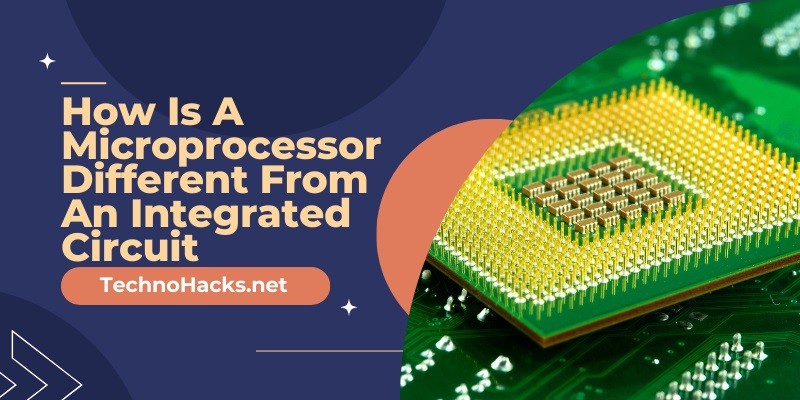Last Updated on May 5, 2025 by Jim C.
In the realm of modern electronics, two components stand out as fundamental building blocks: the microprocessor and the integrated circuit (IC). While closely related, these two elements serve distinct purposes and have unique characteristics that set them apart. This article delves into the key differences between microprocessors and integrated circuits, exploring their histories, functions, and impacts on technology.
Defining the Basics
An integrated circuit, often referred to as an IC or chip, is a set of electronic circuits on a small, flat piece of semiconductor material, typically silicon. ICs can contain anywhere from a few to billions of transistors, resistors, and capacitors, all working together to perform specific functions. The invention of the IC in the late 1950s by Jack Kilby at Texas Instruments marked a revolutionary step in electronics, paving the way for the miniaturization and increased functionality of electronic devices.
On the other hand, a microprocessor is a specific type of integrated circuit that serves as the central processing unit (CPU) of a computer or other electronic device. It’s essentially the “brain” of a computer, responsible for executing instructions and performing calculations. The first commercially available microprocessor, the Intel 4004, was introduced in 1971, ushering in a new era of computing and digital technology.
Key Differences
- Purpose and Function:
The primary distinction between microprocessors and integrated circuits lies in their purpose. While all microprocessors are integrated circuits, not all integrated circuits are microprocessors. ICs can be designed for a wide range of specific functions, such as amplification, switching, or data storage. Microprocessors, however, are specifically designed to process and execute instructions, performing complex computational tasks. - Complexity:
Microprocessors are generally more complex than typical integrated circuits. A modern microprocessor can contain billions of transistors and intricate architectures designed to handle a variety of computing tasks. In contrast, other types of ICs may have simpler structures tailored to perform specific functions efficiently. - Versatility:
Microprocessors are highly versatile, capable of executing a wide range of instructions and adapting to various computing tasks. This flexibility allows them to power devices from personal computers to smartphones. Other ICs are often more specialized, designed to excel at particular functions but lacking the broad capabilities of a microprocessor. - Processing Power:
Microprocessors are built to provide significant processing power, with modern CPUs capable of performing billions of operations per second. While some specialized ICs may also offer high performance in specific areas, they generally don’t match the raw computational power of microprocessors. - Architecture:
A microprocessor typically includes several key components such as the arithmetic logic unit (ALU), control unit, and registers. This complex architecture allows it to fetch, decode, and execute instructions. Other ICs may have simpler architectures focused on their specific functions.
Historical Evolution
The development of both integrated circuits and microprocessors has been marked by rapid advancement and innovation. The first IC, created by Jack Kilby in 1958, contained only a few components. This invention quickly led to the development of more complex circuits, setting the stage for the microprocessor.
The introduction of the Intel 4004 in 1971 marked the birth of the microprocessor era. This 4-bit CPU, though primitive by today’s standards, demonstrated the potential for putting an entire computer’s central processing unit on a single chip. The subsequent decades saw exponential growth in the capabilities of microprocessors, following Moore’s Law, which predicted that the number of transistors on a microchip would double approximately every two years.
As microprocessors evolved, so did the broader field of integrated circuits. Various specialized ICs were developed for specific applications, including memory chips, signal processors, and power management circuits. This diversification has led to the creation of highly efficient and specialized electronic components that work alongside microprocessors in modern devices.
Applications and Impact
The applications of microprocessors and integrated circuits are vast and continually expanding. Microprocessors are at the heart of personal computers, smartphones, tablets, and countless other digital devices. They power everything from simple calculators to complex servers running cloud computing services.
Integrated circuits, in their various forms, are found in virtually every electronic device. They control the functions of household appliances, automotive systems, medical devices, and industrial equipment. The ubiquity of ICs has enabled the development of smaller, more efficient, and more affordable electronic products.
The impact of these technologies on society has been profound. The microprocessor revolution has transformed how we work, communicate, and access information. Integrated circuits have made possible the miniaturization of electronics, leading to portable devices that have become integral to modern life.
Challenges and Future Trends
Both microprocessors and integrated circuits face ongoing challenges, particularly in terms of power consumption and heat generation. As devices become smaller and more powerful, managing these issues becomes increasingly critical. Researchers and engineers are constantly working on new materials and designs to improve efficiency and performance.
The future of these technologies is likely to see continued miniaturization and increased integration. We may see more specialized processors designed for specific tasks, such as artificial intelligence or quantum computing. In the realm of ICs, advancements in materials science and fabrication techniques may lead to even smaller, more efficient circuits.
Conclusion
While microprocessors and integrated circuits are closely related, they serve distinct roles in the world of electronics. Microprocessors, with their complex architectures and versatile processing capabilities, function as the brains of our computing devices. Integrated circuits, encompassing a broader category of components, provide the specialized functions that enable a wide range of electronic applications.

